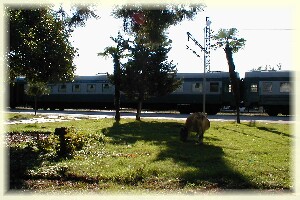 Shortly after seven in the morning, the guard wakes us. I'm sure that he wouldn't win the price as "friendliest guard of the train".
A quick look out of the window shows us a wild landscape with a small river and steep hills in the back and completely
rotten industrial facilities in the foreground, soaked in the mild morning sun. Before eight - on time by the way - we arrive in
Tbilisi. The dirty train station is full of people with a lot of luggage, which often seems to be heavier than the carrying person itself.
We follow the stream of people and walk down the stairs. A long and dark corridor with uneven floor leads to the exit.
Above every exit, one naked bulb dangles from the ceiling, with half of them working. The quest for coffee brings us to one
of the numerous kiosks lining up in front of the station. A drunken Georgian, quaffing vodka, immediately starts a conversation.
He invites us to a vodka, but we rather stick to a coffee. A master of arts he is, he says. Probably a master of the art of living.
The typical questions follow -
where we are from, why the heck we've chosen Georgia as our travel destination and so on. It doesn't matter when to drink,
let it be morning or evening. There would be many bad people in and around the train station, so we should better
walk away quickly. Yes, I believe him. He insists on paying our coffee, although the shopkeeper intervenes 'And how are you planning to
pay your bill?', and wishes all the best.
Shortly after seven in the morning, the guard wakes us. I'm sure that he wouldn't win the price as "friendliest guard of the train".
A quick look out of the window shows us a wild landscape with a small river and steep hills in the back and completely
rotten industrial facilities in the foreground, soaked in the mild morning sun. Before eight - on time by the way - we arrive in
Tbilisi. The dirty train station is full of people with a lot of luggage, which often seems to be heavier than the carrying person itself.
We follow the stream of people and walk down the stairs. A long and dark corridor with uneven floor leads to the exit.
Above every exit, one naked bulb dangles from the ceiling, with half of them working. The quest for coffee brings us to one
of the numerous kiosks lining up in front of the station. A drunken Georgian, quaffing vodka, immediately starts a conversation.
He invites us to a vodka, but we rather stick to a coffee. A master of arts he is, he says. Probably a master of the art of living.
The typical questions follow -
where we are from, why the heck we've chosen Georgia as our travel destination and so on. It doesn't matter when to drink,
let it be morning or evening. There would be many bad people in and around the train station, so we should better
walk away quickly. Yes, I believe him. He insists on paying our coffee, although the shopkeeper intervenes 'And how are you planning to
pay your bill?', and wishes all the best.
|
Picture: Batumi's 'ugly' train station and one of the countless cows
|
We have plenty of time, and so we start walking to the city centre. We've got the address of some private
accommodation. The streets are lined with trees and the air is still fresh. On the way to the centre we
are looking for a bank with an ATM, but we cannot find one. After a longer search and with the help of some
passengers we can finally find the house, hidden in a courtyard. A friendly but austerely looking older woman
opens the door. Yes, we can stay here, she says, and shows us a huge living room with a double bed.
That's 5 US dollars per night and person, to be paid in US dollar only. A fair price. We drop our luggage and go
outside for a first walk through the city.
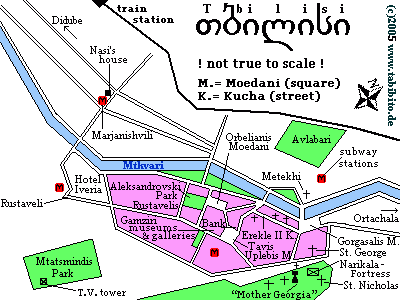 Tbilisi aka Tbilissi aka Tiflis has around 1.5 m inhabitants, which means that every third Georgian lives
in the capital. The river Mtkvari divides the city into North and South, or Left Bank and Right Bank.
The old city centre stretches along the south (right) bank of the river. The train station is in the north-west of
Tbilisi and quite far away from the centre. Although the city was conquered some 30 times by foreign powers during
the last 1500 years, there's plenty to see. But it's not only the historic sites but also the vibrant, cosmopolitan atmosphere
that is interesting. The socialist architecture around Hotel Iveria, nowadays a refugee camp, the churches near
Methekis bridge between Erekle II Kucha and Abesadzis Kucha (Kucha means street), the chic Tbilisi with its
spacious administration buildings and beautiful shops along Rustaveli Gamziri, the view from Narikala fortress
over the city, just to name but a few - there's much to see in Tbilisi, and almost everything is within walking distance.
Tbilisi aka Tbilissi aka Tiflis has around 1.5 m inhabitants, which means that every third Georgian lives
in the capital. The river Mtkvari divides the city into North and South, or Left Bank and Right Bank.
The old city centre stretches along the south (right) bank of the river. The train station is in the north-west of
Tbilisi and quite far away from the centre. Although the city was conquered some 30 times by foreign powers during
the last 1500 years, there's plenty to see. But it's not only the historic sites but also the vibrant, cosmopolitan atmosphere
that is interesting. The socialist architecture around Hotel Iveria, nowadays a refugee camp, the churches near
Methekis bridge between Erekle II Kucha and Abesadzis Kucha (Kucha means street), the chic Tbilisi with its
spacious administration buildings and beautiful shops along Rustaveli Gamziri, the view from Narikala fortress
over the city, just to name but a few - there's much to see in Tbilisi, and almost everything is within walking distance.
|
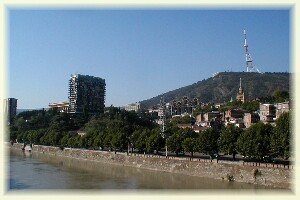 The huge Hotel Iveria (for a detailed picture see →Georgia) with its big
fountain and the monumental concrete sculpture are quite interesting and a Georgian phenomenon. It looks like there is no
other solution to shelter the civil war refugees, and so they have to live for many years in rather poor living condition - but at
least in a perfect location, although the location in the heart of Tbilisi is of no use for the refugees. Right next to the hotel
starts Tbilisi's chic boulevard Rustaveli Gamziri - a beautiful, broad road with many interesting buildings and definitely too
much traffic.
The huge Hotel Iveria (for a detailed picture see →Georgia) with its big
fountain and the monumental concrete sculpture are quite interesting and a Georgian phenomenon. It looks like there is no
other solution to shelter the civil war refugees, and so they have to live for many years in rather poor living condition - but at
least in a perfect location, although the location in the heart of Tbilisi is of no use for the refugees. Right next to the hotel
starts Tbilisi's chic boulevard Rustaveli Gamziri - a beautiful, broad road with many interesting buildings and definitely too
much traffic.
|
Picture: The centre of town at river Mtkvari; the huge building is the Hotel Iveria
|
When walking along Rustaveli Gamziri, one will end up at Tavis-Uplebis Moedani (Moedani means square).
There's a Modern Art Gallery and the Janashia Museum of Georgia nearby. There's also a bank facing Tavis Uplebis square
with an ATM - at least they installed one in 2002, so it should be working by the time you read this. They also offer cash advance
on credit cards. When you walk direction river Mtkvari, you can see the oldest part of the town along Shavtelis-Kucha.
The partially cobbled streets are very narrow, with many churches, museums and galleries concentrating in this area.
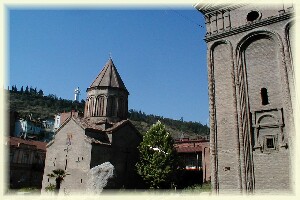 The riverside right behind the Metekhis bridge is quite interesting. There, small houses nestle atop a wall of rocks
high above the river valley. On the right bank of the river, right behind the Armenian St George cathedrale,
the big Narikala fortress sits on the top of a hill, overlooking the entire city. It's rather easy to climb this steep hill.
In front of the entrance to the fortress, there's another church called St Nicholas. There, a toothless old bag, probably the
cleaning lady, comes to us. She shows us where to enter the church. And asks for money. I give her some money, and she
looks happy. When we get out ouf the church, she starts to tell us the story of her life. Which takes two minutes.
And ends with the question for more money, US dollar if possible. So, one time isn't enough? As a matter of fact, many
Georgians are poverty-stricken. Social welfare is virtually non-existent in Georgia. You couldn't bring enough money even if
you would give only a penny to every beggar. However, asking the same person twice for money is something I cannot understand.
And so we refuse to give her more money.
The riverside right behind the Metekhis bridge is quite interesting. There, small houses nestle atop a wall of rocks
high above the river valley. On the right bank of the river, right behind the Armenian St George cathedrale,
the big Narikala fortress sits on the top of a hill, overlooking the entire city. It's rather easy to climb this steep hill.
In front of the entrance to the fortress, there's another church called St Nicholas. There, a toothless old bag, probably the
cleaning lady, comes to us. She shows us where to enter the church. And asks for money. I give her some money, and she
looks happy. When we get out ouf the church, she starts to tell us the story of her life. Which takes two minutes.
And ends with the question for more money, US dollar if possible. So, one time isn't enough? As a matter of fact, many
Georgians are poverty-stricken. Social welfare is virtually non-existent in Georgia. You couldn't bring enough money even if
you would give only a penny to every beggar. However, asking the same person twice for money is something I cannot understand.
And so we refuse to give her more money.
|
Picture: Churches lining up along Shavtelis Kucha; very small in the background Mother Georgia
|
According to legends, the oldest part of the fortress can be dated back to the 4th century, but there's not much left
oft the structure, which is due to a huge explosion in 1827. The view of the town and the surrounding from the fortress is
just splendid. When you keep on walking along the ridge of the hill, you will get to Kartlis Deda, the "Mother of Georgia",
a giant statue which can be seen from almost every place in the town. In one hand she has a bowl of wine, for the
friends of Georgia, in the other a huge sword for the enemies of the country. I would opt for the first one. Some policemen
are loitering at the monument, staring at us as if we would be aliens. Don't you get any ideas! But it's siesta time and nothing
to be afraid of. Somehow we cross a suspicious living quarter and return to the centre of town. Our late lunch consists of chranili,
a typical Georgian dish. These are meat dumplings, like the Chinese counterpart baozi. The dough is thick and the dumplings
are folded up at the top.
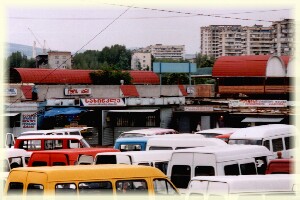 A double portion together with some coffee and soda costs 6 Lari only. After that, we take the subway to see some other
parts of the town. The subway stations are extremely deep, and although the escalators are faster than usual, it takes
a while until we get to the platform. There are two subway lines only, and the distance between the stations is quite long,
so it's not very useful in the city centre. However, it's an easy way to get to the suburbs.
In the evening, we try another Georgian speciality, called khachapuri. When looking from the top, it looks like a
huge eye. Khachapuri is boat-shaped bread with some sheep's milk cheese and an egg in the middle. But there other types, too.
It tastes great and is very filling.
A double portion together with some coffee and soda costs 6 Lari only. After that, we take the subway to see some other
parts of the town. The subway stations are extremely deep, and although the escalators are faster than usual, it takes
a while until we get to the platform. There are two subway lines only, and the distance between the stations is quite long,
so it's not very useful in the city centre. However, it's an easy way to get to the suburbs.
In the evening, we try another Georgian speciality, called khachapuri. When looking from the top, it looks like a
huge eye. Khachapuri is boat-shaped bread with some sheep's milk cheese and an egg in the middle. But there other types, too.
It tastes great and is very filling.
There are also some Internet cafés in Tbilisi, many of them concentrating around Rustaveli subway station.
One hour costs around 2 Lari, but the connection is rather slow.
|
Picture: Didube bus terminal with hords of marshrutkas
|
|
 Shortly after seven in the morning, the guard wakes us. I'm sure that he wouldn't win the price as "friendliest guard of the train".
A quick look out of the window shows us a wild landscape with a small river and steep hills in the back and completely
rotten industrial facilities in the foreground, soaked in the mild morning sun. Before eight - on time by the way - we arrive in
Tbilisi. The dirty train station is full of people with a lot of luggage, which often seems to be heavier than the carrying person itself.
We follow the stream of people and walk down the stairs. A long and dark corridor with uneven floor leads to the exit.
Above every exit, one naked bulb dangles from the ceiling, with half of them working. The quest for coffee brings us to one
of the numerous kiosks lining up in front of the station. A drunken Georgian, quaffing vodka, immediately starts a conversation.
He invites us to a vodka, but we rather stick to a coffee. A master of arts he is, he says. Probably a master of the art of living.
The typical questions follow -
where we are from, why the heck we've chosen Georgia as our travel destination and so on. It doesn't matter when to drink,
let it be morning or evening. There would be many bad people in and around the train station, so we should better
walk away quickly. Yes, I believe him. He insists on paying our coffee, although the shopkeeper intervenes 'And how are you planning to
pay your bill?', and wishes all the best.
Shortly after seven in the morning, the guard wakes us. I'm sure that he wouldn't win the price as "friendliest guard of the train".
A quick look out of the window shows us a wild landscape with a small river and steep hills in the back and completely
rotten industrial facilities in the foreground, soaked in the mild morning sun. Before eight - on time by the way - we arrive in
Tbilisi. The dirty train station is full of people with a lot of luggage, which often seems to be heavier than the carrying person itself.
We follow the stream of people and walk down the stairs. A long and dark corridor with uneven floor leads to the exit.
Above every exit, one naked bulb dangles from the ceiling, with half of them working. The quest for coffee brings us to one
of the numerous kiosks lining up in front of the station. A drunken Georgian, quaffing vodka, immediately starts a conversation.
He invites us to a vodka, but we rather stick to a coffee. A master of arts he is, he says. Probably a master of the art of living.
The typical questions follow -
where we are from, why the heck we've chosen Georgia as our travel destination and so on. It doesn't matter when to drink,
let it be morning or evening. There would be many bad people in and around the train station, so we should better
walk away quickly. Yes, I believe him. He insists on paying our coffee, although the shopkeeper intervenes 'And how are you planning to
pay your bill?', and wishes all the best.
 The huge Hotel Iveria (for a detailed picture see →Georgia) with its big
fountain and the monumental concrete sculpture are quite interesting and a Georgian phenomenon. It looks like there is no
other solution to shelter the civil war refugees, and so they have to live for many years in rather poor living condition - but at
least in a perfect location, although the location in the heart of Tbilisi is of no use for the refugees. Right next to the hotel
starts Tbilisi's chic boulevard Rustaveli Gamziri - a beautiful, broad road with many interesting buildings and definitely too
much traffic.
The huge Hotel Iveria (for a detailed picture see →Georgia) with its big
fountain and the monumental concrete sculpture are quite interesting and a Georgian phenomenon. It looks like there is no
other solution to shelter the civil war refugees, and so they have to live for many years in rather poor living condition - but at
least in a perfect location, although the location in the heart of Tbilisi is of no use for the refugees. Right next to the hotel
starts Tbilisi's chic boulevard Rustaveli Gamziri - a beautiful, broad road with many interesting buildings and definitely too
much traffic.
 The riverside right behind the Metekhis bridge is quite interesting. There, small houses nestle atop a wall of rocks
high above the river valley. On the right bank of the river, right behind the Armenian St George cathedrale,
the big Narikala fortress sits on the top of a hill, overlooking the entire city. It's rather easy to climb this steep hill.
In front of the entrance to the fortress, there's another church called St Nicholas. There, a toothless old bag, probably the
cleaning lady, comes to us. She shows us where to enter the church. And asks for money. I give her some money, and she
looks happy. When we get out ouf the church, she starts to tell us the story of her life. Which takes two minutes.
And ends with the question for more money, US dollar if possible. So, one time isn't enough? As a matter of fact, many
Georgians are poverty-stricken. Social welfare is virtually non-existent in Georgia. You couldn't bring enough money even if
you would give only a penny to every beggar. However, asking the same person twice for money is something I cannot understand.
And so we refuse to give her more money.
The riverside right behind the Metekhis bridge is quite interesting. There, small houses nestle atop a wall of rocks
high above the river valley. On the right bank of the river, right behind the Armenian St George cathedrale,
the big Narikala fortress sits on the top of a hill, overlooking the entire city. It's rather easy to climb this steep hill.
In front of the entrance to the fortress, there's another church called St Nicholas. There, a toothless old bag, probably the
cleaning lady, comes to us. She shows us where to enter the church. And asks for money. I give her some money, and she
looks happy. When we get out ouf the church, she starts to tell us the story of her life. Which takes two minutes.
And ends with the question for more money, US dollar if possible. So, one time isn't enough? As a matter of fact, many
Georgians are poverty-stricken. Social welfare is virtually non-existent in Georgia. You couldn't bring enough money even if
you would give only a penny to every beggar. However, asking the same person twice for money is something I cannot understand.
And so we refuse to give her more money.
 A double portion together with some coffee and soda costs 6 Lari only. After that, we take the subway to see some other
parts of the town. The subway stations are extremely deep, and although the escalators are faster than usual, it takes
a while until we get to the platform. There are two subway lines only, and the distance between the stations is quite long,
so it's not very useful in the city centre. However, it's an easy way to get to the suburbs.
In the evening, we try another Georgian speciality, called khachapuri. When looking from the top, it looks like a
huge eye. Khachapuri is boat-shaped bread with some sheep's milk cheese and an egg in the middle. But there other types, too.
It tastes great and is very filling.
A double portion together with some coffee and soda costs 6 Lari only. After that, we take the subway to see some other
parts of the town. The subway stations are extremely deep, and although the escalators are faster than usual, it takes
a while until we get to the platform. There are two subway lines only, and the distance between the stations is quite long,
so it's not very useful in the city centre. However, it's an easy way to get to the suburbs.
In the evening, we try another Georgian speciality, called khachapuri. When looking from the top, it looks like a
huge eye. Khachapuri is boat-shaped bread with some sheep's milk cheese and an egg in the middle. But there other types, too.
It tastes great and is very filling.